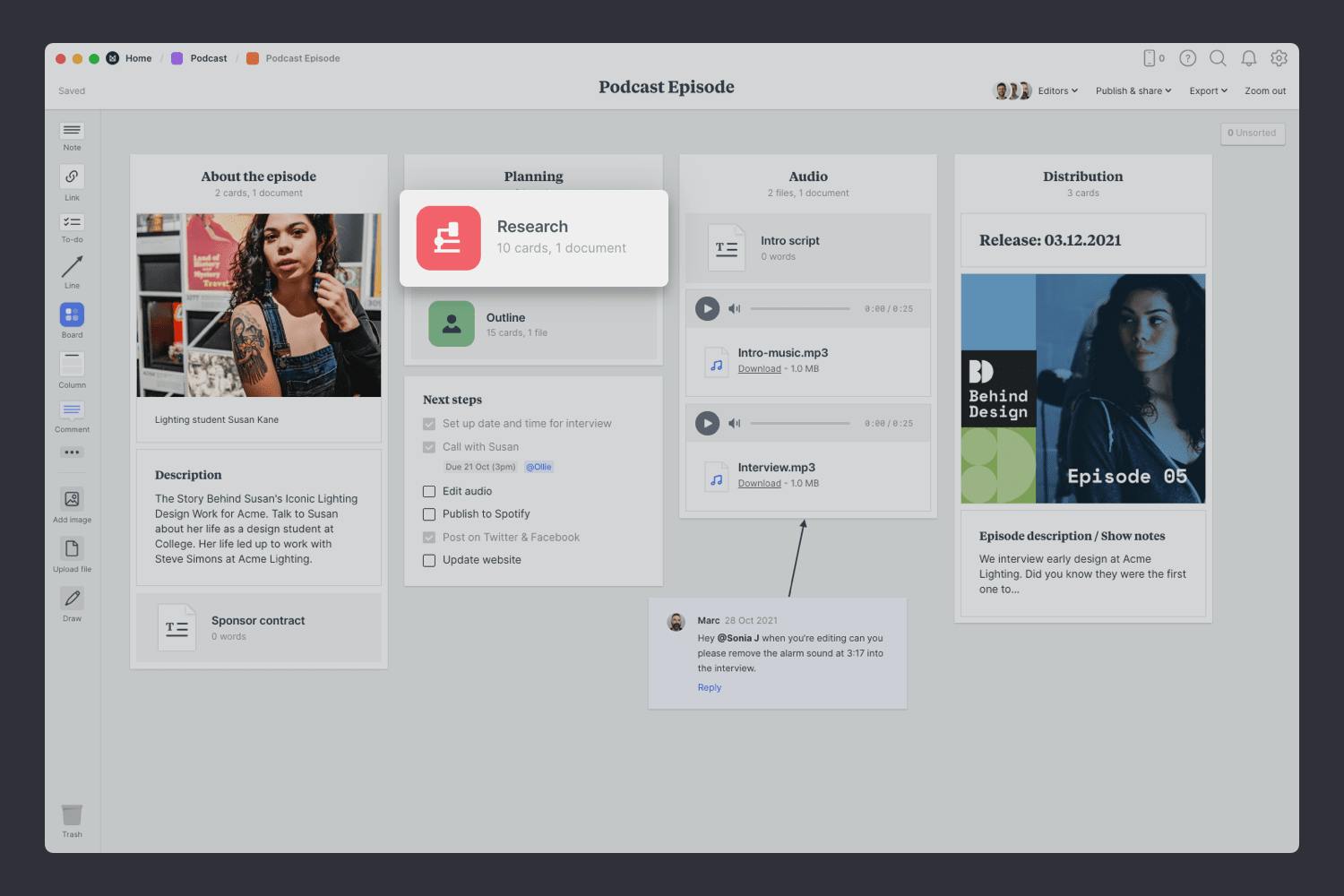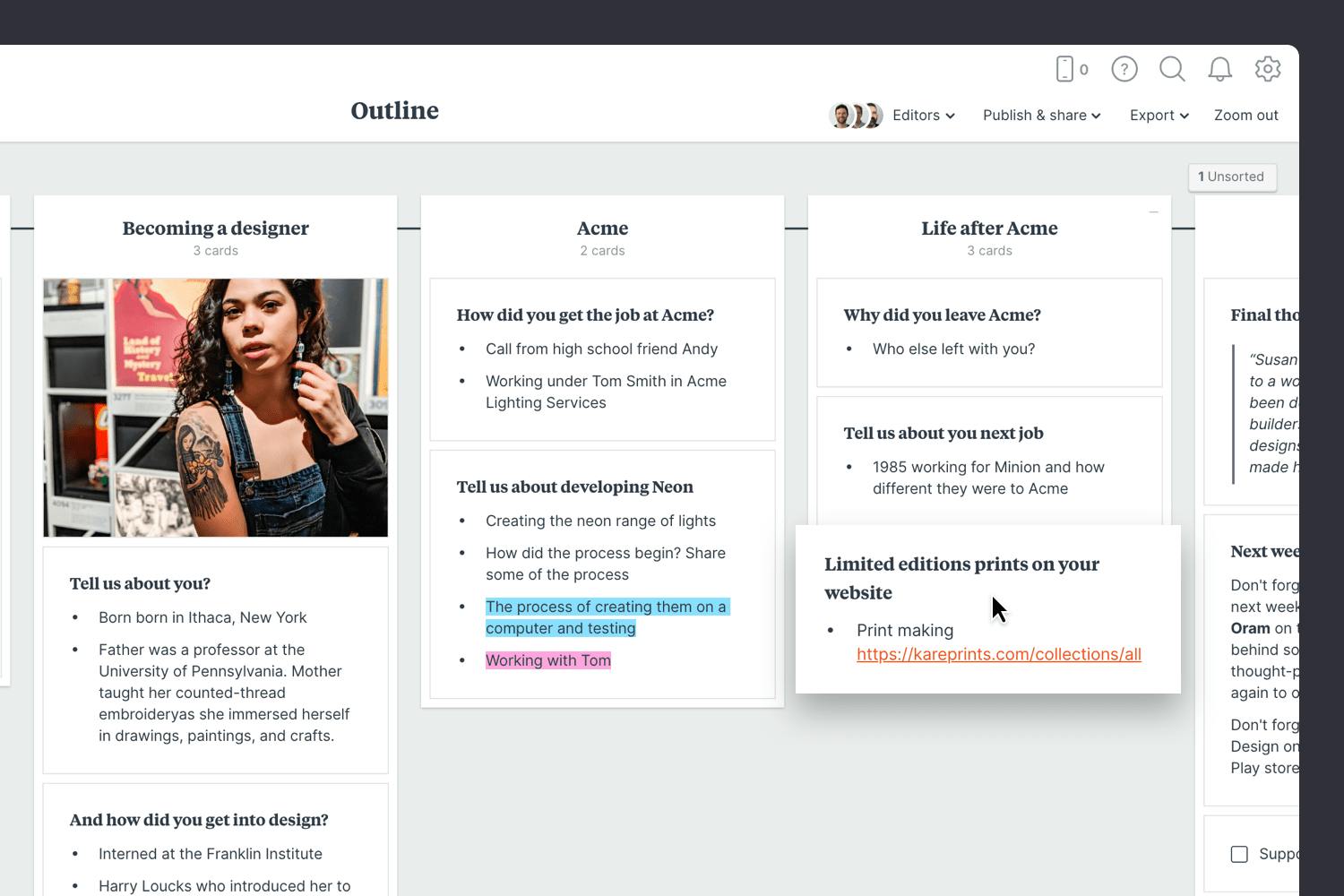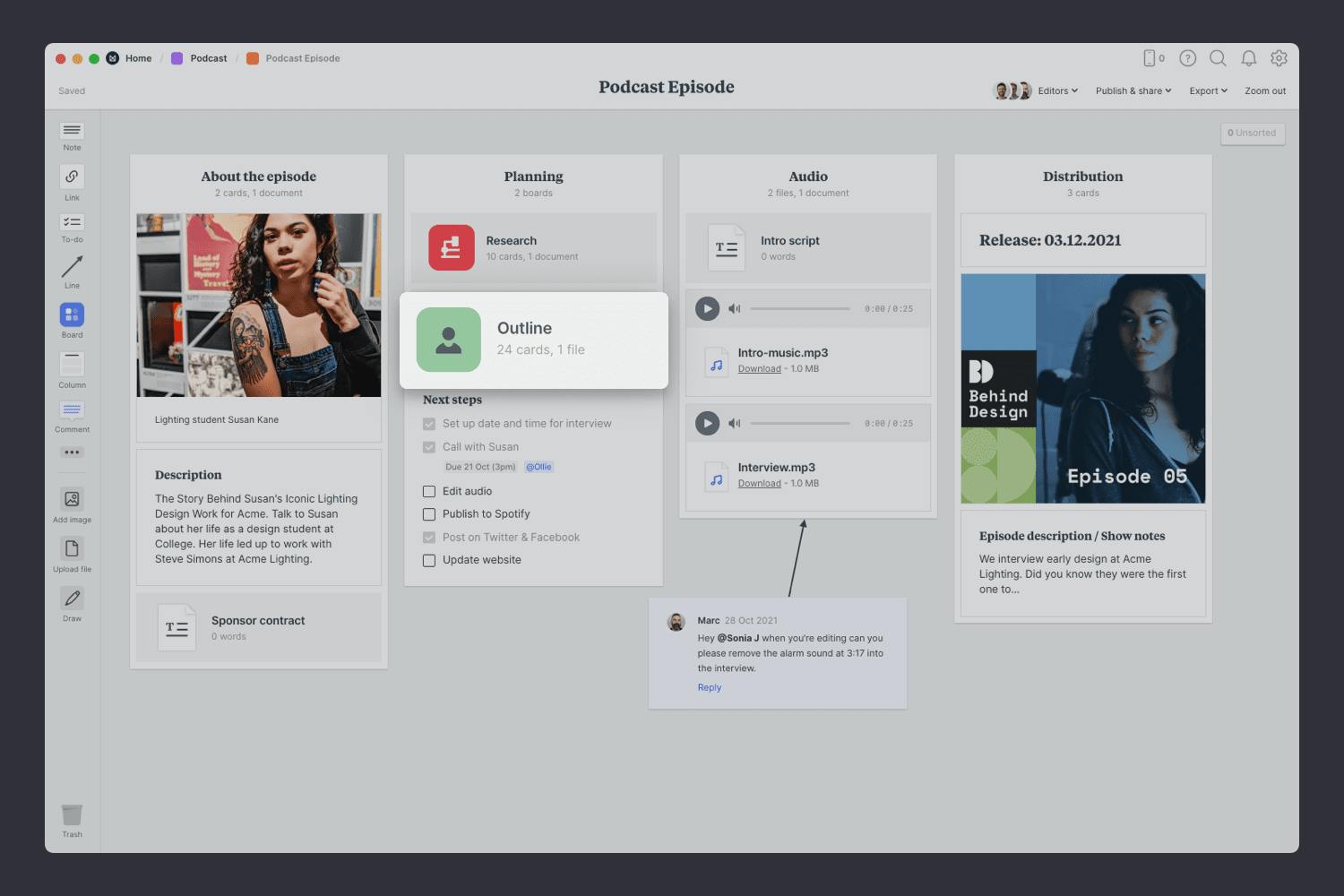Start planning your episode
Get all 3 podcast templates FREE and start planning in minutes.
Get startedSign up for free with no time limit

Follow this step-by-step guide to learn the modern process of planning a podcast in Milanote, a free tool used by top creatives.

Starting a new podcast episode can be an exciting but daunting moment. It's the beginning of the creative process—where your mind is overflowing with ideas, inspiration, and plans. This guide will help you organize everything in one place so you can start recording with confidence. You'll brainstorm ideas, collect inspiration, research your topic, and create an outline for your episode. At the end you'll have a solid plan that will speed up the entire process and help you produce an engaging podcast.
Traditionally, your ideas and plans might be scattered across various sticky notes, to-do lists, spreadsheets, and documents making it hard to keep track of everything and get a bird's-eye view of your show. A central project plan combines these artifacts into one easy-to-access place. It will evolve over the lifespan of your podcast but usually includes:

Create a new board to plan your episode.
Drag a board out from the toolbar. Give it a name, then double click to open it.
Choose the Podcast Episode Plan template.
Each new board gives you the options to start with a beautiful template.
Whether your podcast is a true-crime thriller or an interview series, research is a crucial step in the early creative process. It's a springboard for new ideas and can add substance and authenticity to each episode. As author Robert McKee says "when you do enough research, the story almost writes itself. Lines of development spring loose and you'll have choices galore." When you bring your research into one place and see things side-by-side, new ideas and perspectives start to emerge.

You’ll find the board for collecting research on your Podcast Episode Plan board. Double click the Research board to open it and get started.

Double click the Research board to open it.
Wikipedia, blogs, and news websites are a goldmine for researchers. It's here you'll find historical events and records, data, and opinions about your topic. We're in the 'collecting' phase so just save links to any relevant information you stumble across. You can return and read the details at a later stage.

Drag a link card onto your board to save a website.
Install the Milanote Web Clipper
Save websites and articles straight to your board.
With the Web Clipper installed, save a website, image or text. Choose the destination in Milanote. Return to your board and find the content in the "Unsorted" column on the right.
Video and audio are great sources of inspiration for your podcast. Try searching for your topic or guest on Vimeo, or Youtube. Other podcasts are a great reference too. Find conversations about your topic on Spotify or any podcast platform and add them into the mix.

Embed Youtube videos or audio in a board.
Copy the share link from Youtube, Vimeo, Soundcloud or many other services. Drag a link card onto your board, paste your link and press enter.
Sometimes the quickest way to understand a topic is with an image. They can transport you to another time or place and can help you describe things in much more detail. They're also easier to scan when you return to your research. Try saving images from Google Images, Pinterest, or Milanote's built-in image library.

Use the built-in image library.
Search over 3 million beautiful photos powered by Pexels then drag images straight onto your board.
You never know where or when you'll find inspiration—it could strike you in the shower, or as you're strolling the aisles of the grocery store. So make sure you have an easy way to capture things on the go. As creative director Grace Coddington said, "Always keep your eyes open. Keep watching. Because whatever you see can inspire you."

Download the Milanote mobile app
Save photos straight to your Research board.
Shoot or upload photos directly to your board. When you return to a bigger screen you'll find them in the "Unsorted" column of the board.
Research is an ongoing process and you'll probably continue learning about your topic throughout your creative process. Reference your research as you go to add a unique perspective to your show. Read the full guide on Organizing research for your podcast to learn more.
A podcast outline (or script) is the roadmap for your episode. It helps you map out your talking points and plan the sequence of topics you want to cover. It's a simple, flexible technique to help all types of podcasters stay organized and produce compelling shows.
This method is perfect for 'visual thinkers'—those who prefer to see the big picture as a sequence of events, rather than a rigid linear document. Think of it as the modern, digital equivalent to the corkboard or wall of sticky notes, but much easier to manage.

You’ll find the empty Outline board on the Podcast Episode Plan board. Double-click it to start adding the mapping out your script.

Double-click the Outline board to open it.
Start by laying out the major topics or questions you know you want to cover. A great place to start is with the traditional storytelling structure of beginning, middle, and end. Don't worry too much about the order or details yet, just get the main parts out of your head. This is a quick flexible way to brainstorm the centerpieces of your show.

Add a Column for each key topic.
Name it, then drag any relevant notes or images into your column
Next, add a sentence or a bullet point for each talking point or question you might cover. There are no rules for how much detail to add, do what works best for you. You'll be referencing these as you record your podcast, so try and keep them short, snappy, and easy to scan as you're talking. They're the equivalent of cue cards you might use when giving a speech.

Add a note to describe the talking points.
Start typing then use the formatting tools in the left hand toolbar.
Seeing your episode at this level lets you make connections between themes and concepts you might otherwise miss if you wrote a script in a word document. Re-read your outline so far. Look for points that feel out of place. Perhaps your transitions need some tweaking or a topic appears without a proper introduction. Highlight areas that need more work and move points around to get the sequence just right.

Drag plot points around to get the sequence right.
While imagery probably won't make an appearance in your podcast, this is a great technique for kickstarting new ideas. Experiment by adding images or video clips that relate to your topics. You can have them on-hand and reference the details when recording to tell a more vivid story. Try saving images from Google Images, Pinterest, or Milanote's built-in image library.

Use the built-in image library.
Search over 3 million beautiful photos powered by Pexels then drag images straight onto your board.
Drag files from your computer.
Click the "Upload file" button or just drag a file onto your board. You can add images, logos, documents, videos, audio and much more.
With any creative technique or project, it’s important to be open to constructive feedback. Now that the first version of your outline is done it's time to ask for specific feedback on the sequence and talking points from your co-host or team. Make sure you stay open to suggestions and improvements and try not to take criticism personally.
If you're interviewing a guest, it's helpful to share the outline with them before recording. This gives them the opportunity to prepare and results in a deeper, more lively conversation.

Invite a co-host or guest to review the outline.
Open the "Editors" menu from the title bar of your board. Add email addresses of the people you'd like to collaborate with—they'll receive an invitation via email.
Start a comment thread.
Drag out a comment from the toolbar on the left and place it on your board. Other editors can reply to your comment.
Now that you've finished your outline, you can start recording, confident that your episode has a strong foundation. If you want to learn more about this stage, read the full guide on how to outline a podcast.
Once you've published a few episodes, you'll need a way to manage your workflow. You'll likely have multiple episodes in progress at any one time, so this will help you see where everything is at in one view. You'll also see which areas need your attention. For example, do you have enough show ideas in the backlog or should you be focusing on finishing the shows in progress?
Create a new board to setup your Podcast Schedule. Each episode will live inside this board, making the entire process easy to manage.

Create a new board for your Podcast Schedule
Drag a board out from the toolbar. Give it a name, then double-click to open it.
Select the Podcast Schedule template.
Each new board gives you the options to start with a beautiful template.
This template maps out your process from raw idea to published episode. Simply drag and drop episodes into the relevant column to match their status. Everyone works in a different way, so you can update the columns to match your workflow.

Drag and drop boards into different columns
Hopefully, this guide has helped you stay organized while building a solid foundation for your podcast show. If you're just starting a new episode, use the Podcast template below to get set up in minutes.